2013 NISSAN FRONTIER maintenance
[x] Cancel search: maintenancePage 401 of 444
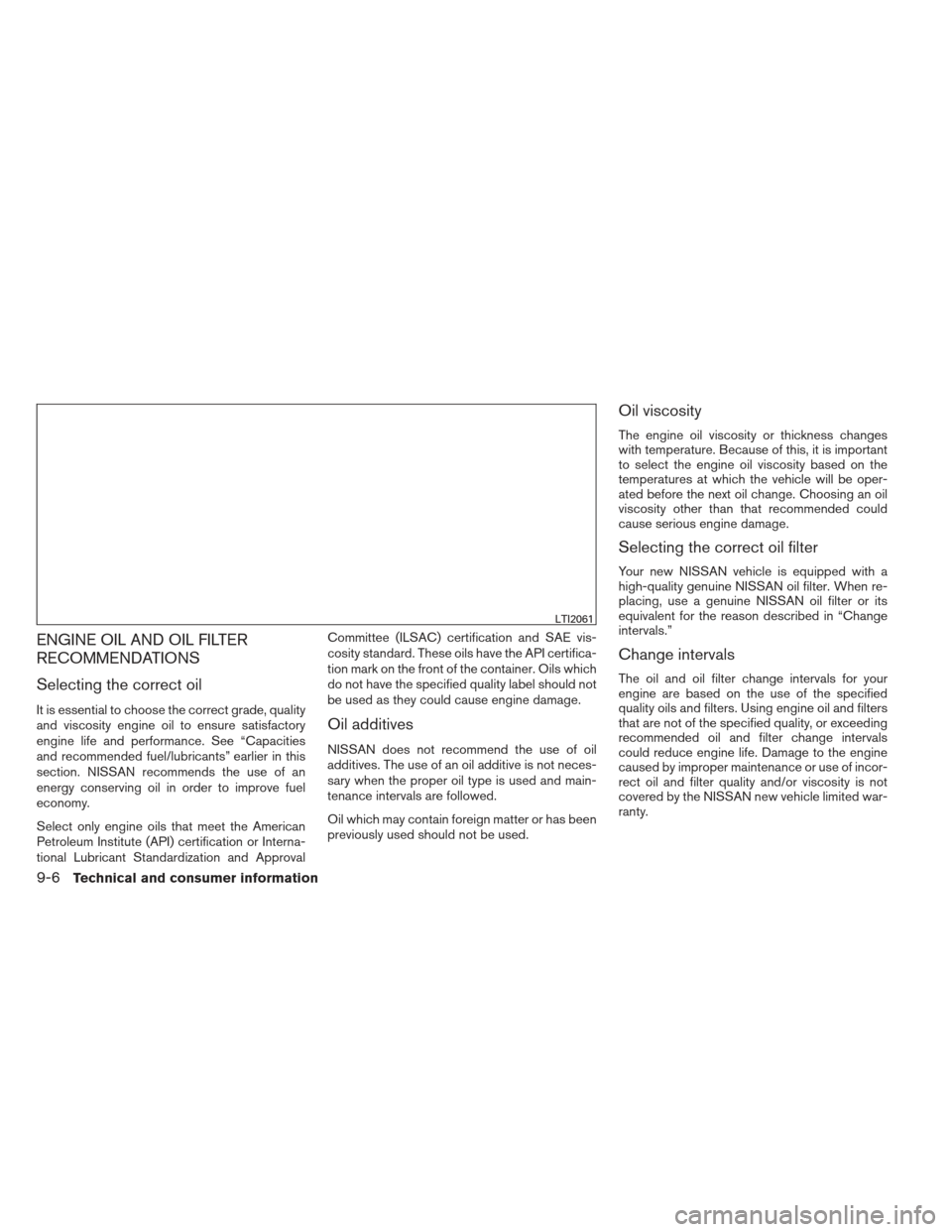
ENGINE OIL AND OIL FILTER
RECOMMENDATIONS
Selecting the correct oil
It is essential to choose the correct grade, quality
and viscosity engine oil to ensure satisfactory
engine life and performance. See “Capacities
and recommended fuel/lubricants” earlier in this
section. NISSAN recommends the use of an
energy conserving oil in order to improve fuel
economy.
Select only engine oils that meet the American
Petroleum Institute (API) certification or Interna-
tional Lubricant Standardization and ApprovalCommittee (ILSAC) certification and SAE vis-
cosity standard. These oils have the API certifica-
tion mark on the front of the container. Oils which
do not have the specified quality label should not
be used as they could cause engine damage.Oil additives
NISSAN does not recommend the use of oil
additives. The use of an oil additive is not neces-
sary when the proper oil type is used and main-
tenance intervals are followed.
Oil which may contain foreign matter or has been
previously used should not be used.
Oil viscosity
The engine oil viscosity or thickness changes
with temperature. Because of this, it is important
to select the engine oil viscosity based on the
temperatures at which the vehicle will be oper-
ated before the next oil change. Choosing an oil
viscosity other than that recommended could
cause serious engine damage.
Selecting the correct oil filter
Your new NISSAN vehicle is equipped with a
high-quality genuine NISSAN oil filter. When re-
placing, use a genuine NISSAN oil filter or its
equivalent for the reason described in “Change
intervals.”
Change intervals
The oil and oil filter change intervals for your
engine are based on the use of the specified
quality oils and filters. Using engine oil and filters
that are not of the specified quality, or exceeding
recommended oil and filter change intervals
could reduce engine life. Damage to the engine
caused by improper maintenance or use of incor-
rect oil and filter quality and/or viscosity is not
covered by the NISSAN new vehicle limited war-
ranty.
LTI2061
9-6Technical and consumer information
Page 402 of 444
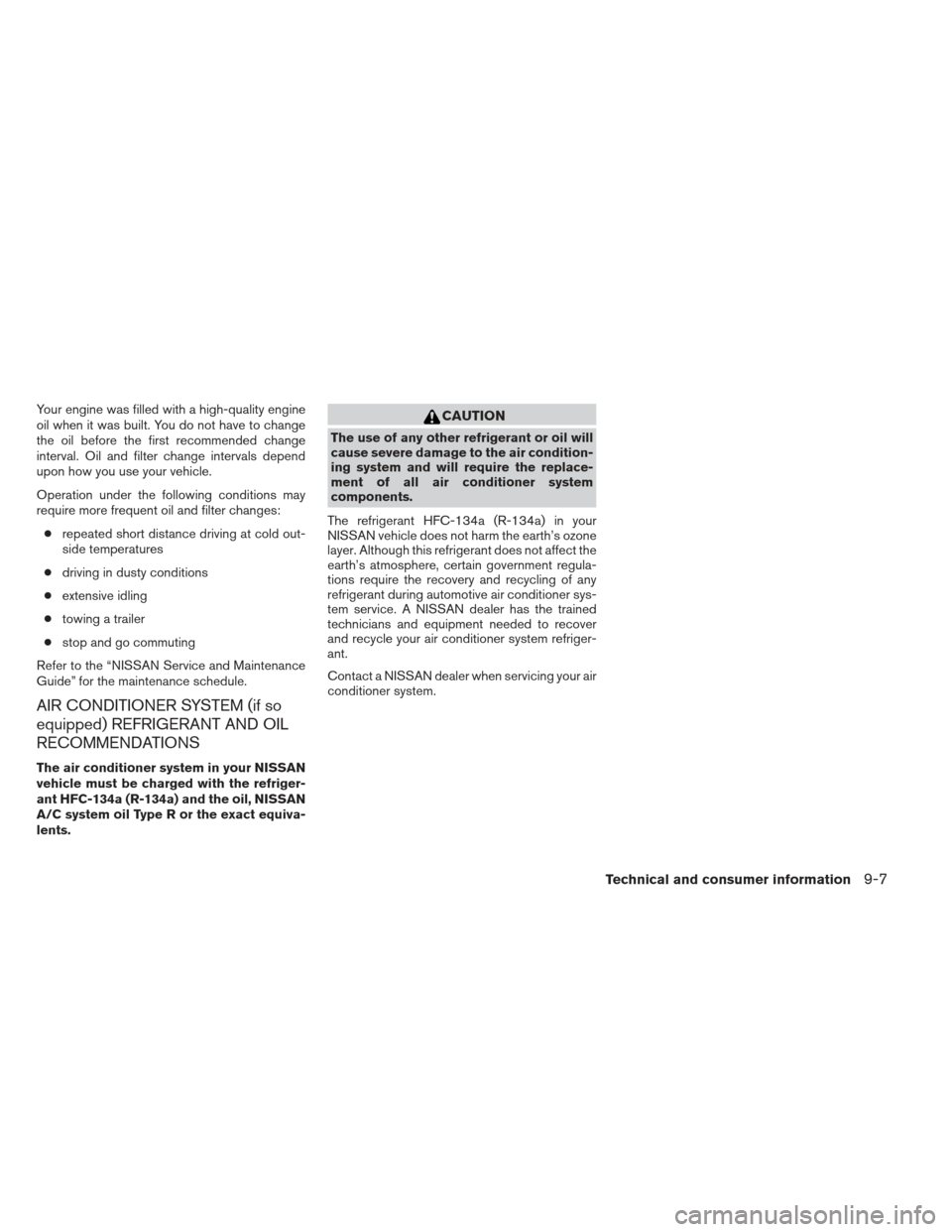
Your engine was filled with a high-quality engine
oil when it was built. You do not have to change
the oil before the first recommended change
interval. Oil and filter change intervals depend
upon how you use your vehicle.
Operation under the following conditions may
require more frequent oil and filter changes:● repeated short distance driving at cold out-
side temperatures
● driving in dusty conditions
● extensive idling
● towing a trailer
● stop and go commuting
Refer to the “NISSAN Service and Maintenance
Guide” for the maintenance schedule.
AIR CONDITIONER SYSTEM (if so
equipped) REFRIGERANT AND OIL
RECOMMENDATIONS
The air conditioner system in your NISSAN
vehicle must be charged with the refriger-
ant HFC-134a (R-134a) and the oil, NISSAN
A/C system oil Type R or the exact equiva-
lents.
CAUTION
The use of any other refrigerant or oil will
cause severe damage to the air condition-
ing system and will require the replace-
ment of all air conditioner system
components.
The refrigerant HFC-134a (R-134a) in your
NISSAN vehicle does not harm the earth’s ozone
layer. Although this refrigerant does not affect the
earth’s atmosphere, certain government regula-
tions require the recovery and recycling of any
refrigerant during automotive air conditioner sys-
tem service. A NISSAN dealer has the trained
technicians and equipment needed to recover
and recycle your air conditioner system refriger-
ant.
Contact a NISSAN dealer when servicing your air
conditioner system.
Technical and consumer information9-7
Page 429 of 444
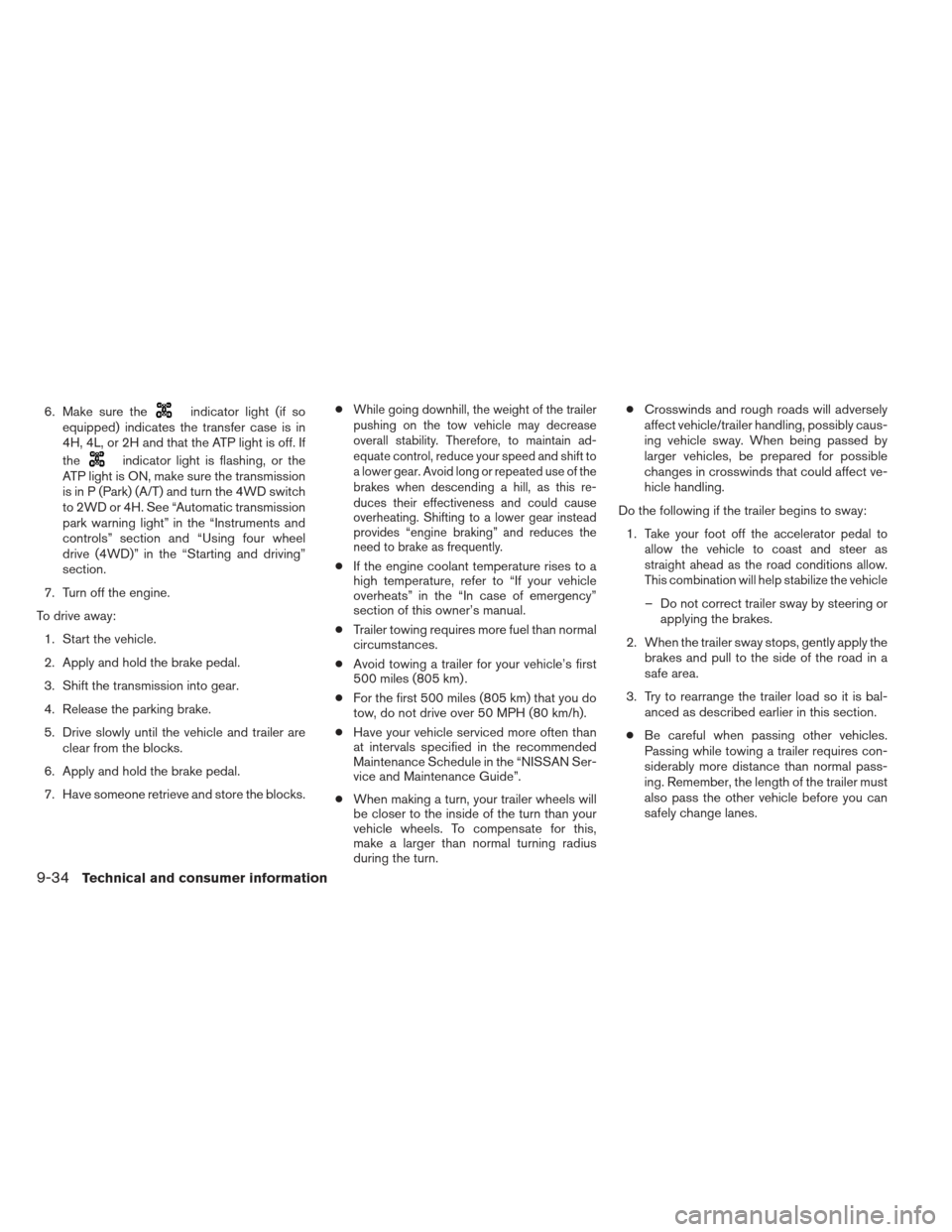
6. Make sure theindicator light (if so
equipped) indicates the transfer case is in
4H, 4L, or 2H and that the ATP light is off. If
the
indicator light is flashing, or the
ATP light is ON, make sure the transmission
is in P (Park) (A/T) and turn the 4WD switch
to 2WD or 4H. See “Automatic transmission
park warning light” in the “Instruments and
controls” section and “Using four wheel
drive (4WD)” in the “Starting and driving”
section.
7. Turn off the engine.
To drive away: 1. Start the vehicle.
2. Apply and hold the brake pedal.
3. Shift the transmission into gear.
4. Release the parking brake.
5. Drive slowly until the vehicle and trailer are clear from the blocks.
6. Apply and hold the brake pedal.
7. Have someone retrieve and store the blocks. ●
While going downhill, the weight of the trailer
pushing on the tow vehicle may decrease
overall stability. Therefore, to maintain ad-
equate control, reduce your speed and shift to
a lower gear. Avoid long or repeated use of the
brakes when descending a hill, as this re-
duces their effectiveness and could cause
overheating. Shifting to a lower gear instead
provides “engine braking” and reduces the
need to brake as frequently.
● If the engine coolant temperature rises to a
high temperature, refer to “If your vehicle
overheats” in the “In case of emergency”
section of this owner’s manual.
● Trailer towing requires more fuel than normal
circumstances.
● Avoid towing a trailer for your vehicle’s first
500 miles (805 km) .
● For the first 500 miles (805 km) that you do
tow, do not drive over 50 MPH (80 km/h).
● Have your vehicle serviced more often than
at intervals specified in the recommended
Maintenance Schedule in the “NISSAN Ser-
vice and Maintenance Guide”.
● When making a turn, your trailer wheels will
be closer to the inside of the turn than your
vehicle wheels. To compensate for this,
make a larger than normal turning radius
during the turn. ●
Crosswinds and rough roads will adversely
affect vehicle/trailer handling, possibly caus-
ing vehicle sway. When being passed by
larger vehicles, be prepared for possible
changes in crosswinds that could affect ve-
hicle handling.
Do the following if the trailer begins to sway: 1.
Take your foot off the accelerator pedal to
allow the vehicle to coast and steer as
straight ahead as the road conditions allow.
This combination will help stabilize the vehicle
– Do not correct trailer sway by steering or applying the brakes.
2. When the trailer sway stops, gently apply the brakes and pull to the side of the road in a
safe area.
3. Try to rearrange the trailer load so it is bal- anced as described earlier in this section.
● Be careful when passing other vehicles.
Passing while towing a trailer requires con-
siderably more distance than normal pass-
ing. Remember, the length of the trailer must
also pass the other vehicle before you can
safely change lanes.
9-34Technical and consumer information
Page 430 of 444
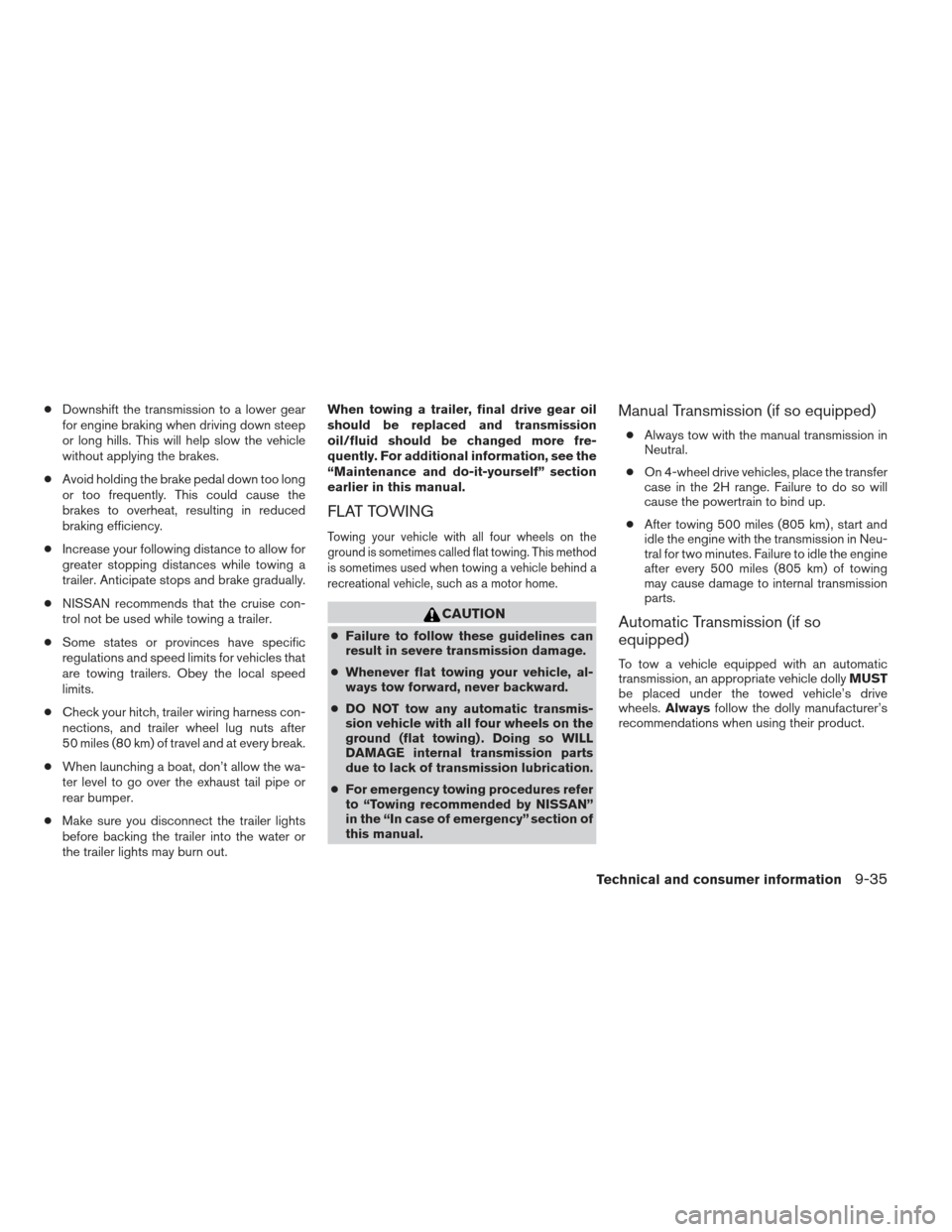
●Downshift the transmission to a lower gear
for engine braking when driving down steep
or long hills. This will help slow the vehicle
without applying the brakes.
● Avoid holding the brake pedal down too long
or too frequently. This could cause the
brakes to overheat, resulting in reduced
braking efficiency.
● Increase your following distance to allow for
greater stopping distances while towing a
trailer. Anticipate stops and brake gradually.
● NISSAN recommends that the cruise con-
trol not be used while towing a trailer.
● Some states or provinces have specific
regulations and speed limits for vehicles that
are towing trailers. Obey the local speed
limits.
● Check your hitch, trailer wiring harness con-
nections, and trailer wheel lug nuts after
50 miles (80 km) of travel and at every break.
● When launching a boat, don’t allow the wa-
ter level to go over the exhaust tail pipe or
rear bumper.
● Make sure you disconnect the trailer lights
before backing the trailer into the water or
the trailer lights may burn out. When towing a trailer, final drive gear oil
should be replaced and transmission
oil/fluid should be changed more fre-
quently. For additional information, see the
“Maintenance and do-it-yourself” section
earlier in this manual.
FLAT TOWING
Towing your vehicle with all four wheels on the
ground is sometimes called flat towing. This method
is sometimes used when towing a vehicle behind a
recreational vehicle, such as a motor home.
CAUTION
●
Failure to follow these guidelines can
result in severe transmission damage.
● Whenever flat towing your vehicle, al-
ways tow forward, never backward.
● DO NOT tow any automatic transmis-
sion vehicle with all four wheels on the
ground (flat towing) . Doing so WILL
DAMAGE internal transmission parts
due to lack of transmission lubrication.
● For emergency towing procedures refer
to “Towing recommended by NISSAN”
in the “In case of emergency” section of
this manual.
Manual Transmission (if so equipped)
● Always tow with the manual transmission in
Neutral.
● On 4-wheel drive vehicles, place the transfer
case in the 2H range. Failure to do so will
cause the powertrain to bind up.
● After towing 500 miles (805 km) , start and
idle the engine with the transmission in Neu-
tral for two minutes. Failure to idle the engine
after every 500 miles (805 km) of towing
may cause damage to internal transmission
parts.
Automatic Transmission (if so
equipped)
To tow a vehicle equipped with an automatic
transmission, an appropriate vehicle dolly MUST
be placed under the towed vehicle’s drive
wheels. Always follow the dolly manufacturer’s
recommendations when using their product.
Technical and consumer information9-35
Page 433 of 444
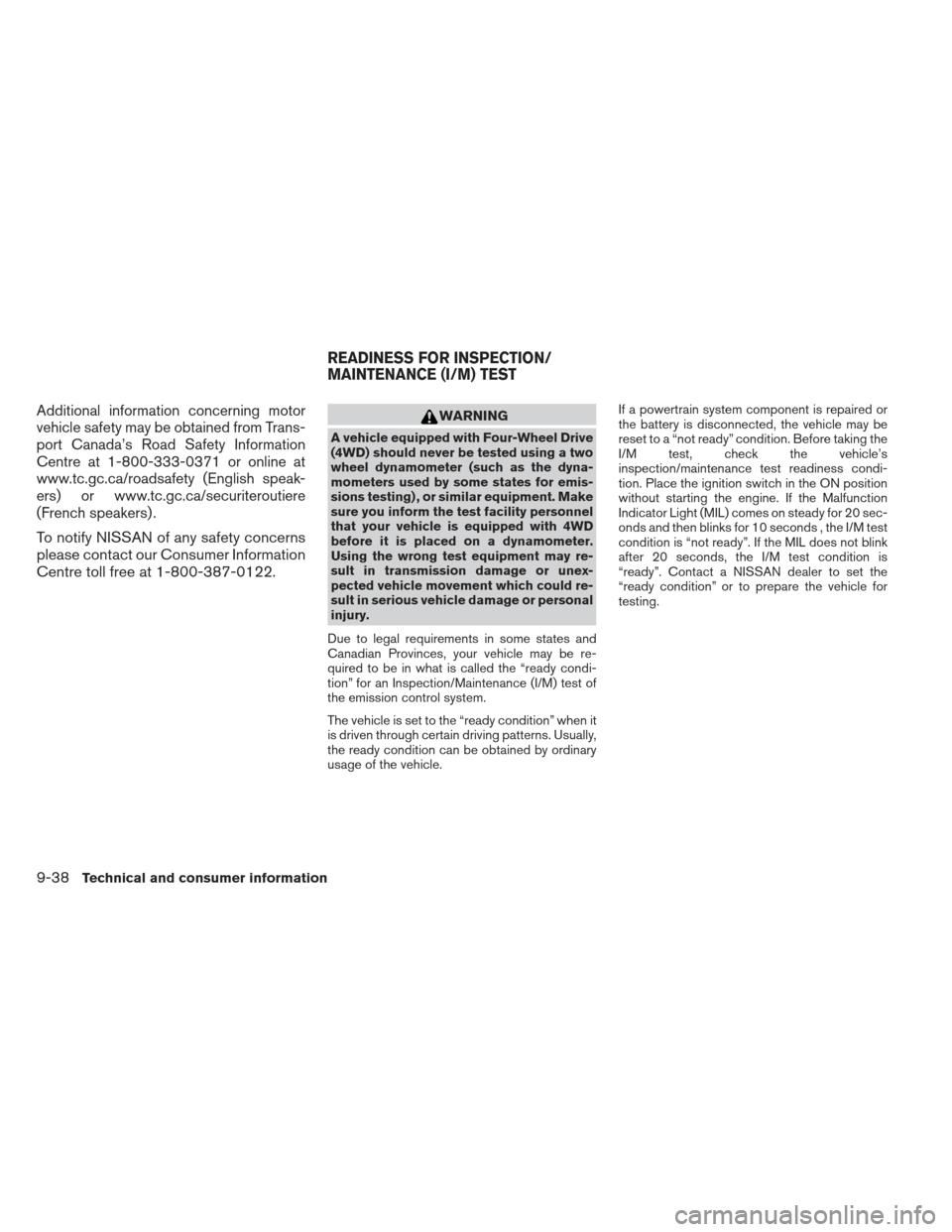
Additional information concerning motor
vehicle safety may be obtained from Trans-
port Canada’s Road Safety Information
Centre at 1-800-333-0371 or online at
www.tc.gc.ca/roadsafety (English speak-
ers) or www.tc.gc.ca/securiteroutiere
(French speakers) .
To notify NISSAN of any safety concerns
please contact our Consumer Information
Centre toll free at 1-800-387-0122.
WARNING
A vehicle equipped with Four-Wheel Drive
(4WD) should never be tested using a two
wheel dynamometer (such as the dyna-
mometers used by some states for emis-
sions testing) , or similar equipment. Make
sure you inform the test facility personnel
that your vehicle is equipped with 4WD
before it is placed on a dynamometer.
Using the wrong test equipment may re-
sult in transmission damage or unex-
pected vehicle movement which could re-
sult in serious vehicle damage or personal
injury.
Due to legal requirements in some states and
Canadian Provinces, your vehicle may be re-
quired to be in what is called the “ready condi-
tion” for an Inspection/Maintenance (I/M) test of
the emission control system.
The vehicle is set to the “ready condition” when it
is driven through certain driving patterns. Usually,
the ready condition can be obtained by ordinary
usage of the vehicle. If a powertrain system component is repaired or
the battery is disconnected, the vehicle may be
reset to a “not ready” condition. Before taking the
I/M test, check the vehicle’s
inspection/maintenance test readiness condi-
tion. Place the ignition switch in the ON position
without starting the engine. If the Malfunction
Indicator Light (MIL) comes on steady for 20 sec-
onds and then blinks for 10 seconds , the I/M test
condition is “not ready”. If the MIL does not blink
after 20 seconds, the I/M test condition is
“ready”. Contact a NISSAN dealer to set the
“ready condition” or to prepare the vehicle for
testing.
READINESS FOR INSPECTION/
MAINTENANCE (I/M) TEST
9-38Technical and consumer information
Page 438 of 444
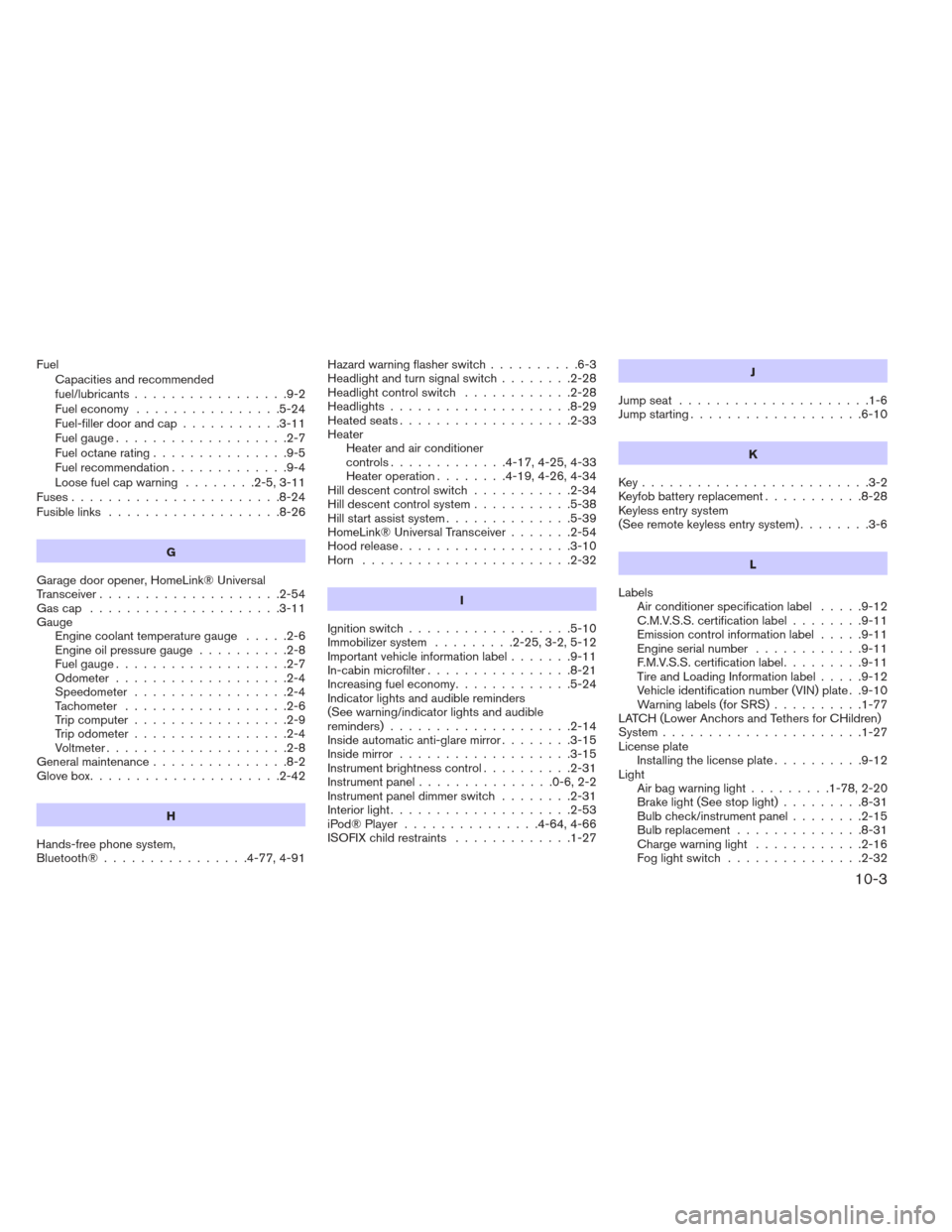
FuelCapacities and recommended
fuel/lubricants .................9-2
Fuel economy ................5-24
Fuel-filler door and cap ...........3-11
Fuel gauge ...................2-7
Fueloctanerating...............9-5
Fuel recommendation .............9-4
Loosefuelcapwarning ........2-5,3-11
Fuses.......................8-24
Fusiblelinks ...................8-26
G
Garage door opener, HomeLink® Universal
Transceiver....................2-54
Gascap .....................3-11
Gauge Engine coolant temperature gauge .....2-6
Engine oil pressure gauge ..........2-8
Fuel gauge ...................2-7
Odometer ...................2-4
Speedometer .................2-4
Tachometer ..................2-6
Trip computer .................2-9
Trip odometer .................2-4
Voltmeter....................2-8
Generalmaintenance...............8-2
Glovebox.....................2-42
H
Hands-free phone system,
Bluetooth®................4-77,4-91 Hazard warning flasher switch
..........6-3
Headlight and turn signal switch ........2-28
Headlight control switch ............2-28
Headlights ....................8-29
Heated seats ...................2-33
Heater Heater and air conditioner
controls.............4-17,4-25,4-33
Heater operation ........4-19,4-26,4-34
Hill descent control switch ...........2-34
Hill descent control system ...........5-38
Hill start assist system ..............5-39
HomeLink® Universal Transceiver .......2-54
Hood release ...................3-10
Horn .......................2-32
I
Ignition switch ..................5-10
Immobilizer system .........2-25,3-2,5-12
Important vehicle information label .......9-11
In-cabin microfilter ................8-21
Increasing fuel economy .............5-24
Indicator lights and audible reminders
(See warning/indicator lights and audible
reminders)....................2-14
Inside automatic anti-glare mirror ........3-15
Inside mirror ...................3-15
Instrument brightness control ..........2-31
Instrument panel ...............0-6,2-2
Instrument panel dimmer switch ........2-31
Interiorlight....................2-53
iPod® Player ...............4-64,4-66
ISOFIX child restraints .............1-27 J
Jumpseat .....................1-6
Jump starting ...................6-10
K
Key.........................3-2
Keyfob battery replacement ...........8-28
Keyless entry system
(See remote keyless entry system) ........3-6
L
Labels Air conditioner specification label .....9-12
C.M.V.S.S. certification label ........9-11
Emission
control information label .....9-11
Engine serial number ............9-11
F.M.V.S.S. certification label .........9-11
Tire and Loading Information label .....9-12
Vehicle identification number (VIN) plate . .9-10
Warning labels (for SRS) ..........1-77
LATCH (Lower Anchors and Tethers for CHildren)
System ......................1-27
License plate Installing the license plate ..........9-12
Light Airbagwarninglight.........1-78, 2-20
Brake light (See stop light) .........8-31
Bulb check/instrument panel ........2-15
Bulbreplacement..............8-31
Charge warning light ............2-16
Fog light switch ...............2-32
10-3
Page 439 of 444
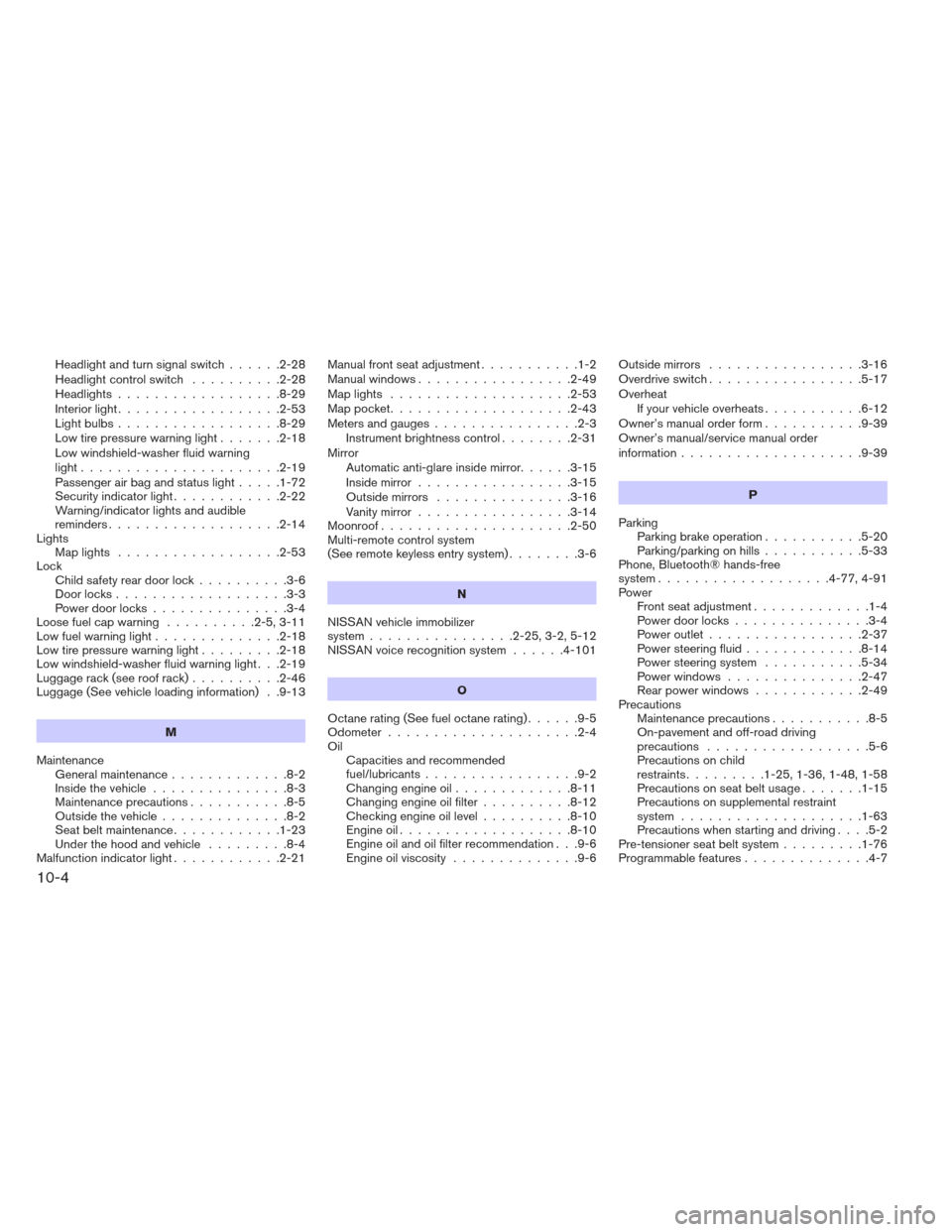
Headlight and turn signal switch......2-28
Headlightcontrolswitch ..........2-28
Headlights..................8-29
Interiorlight..................2-53
Lightbulbs..................8-29
Low tire pressure warning light .......2-18
Low windshield-washer fluid warning
light......................2-19
Passenger air bag and status light .....1-72
Security indicator light ............2-22
Warning/indicator lights and audible
reminders ...................2-14
Lights Maplights ..................2-53
Lock Child safety rear door lock ..........3-6
Door locks ...................3-3
Power door locks ...............3-4
Loose fuel cap warning ..........2-5,3-11
Lowfuelwarninglight..............2-18
Low tire pressure warning light .........2-18
Low windshield-washer fluid warning light . . .2-19
Luggage rack (see roof rack) ..........2-46
Luggage (See vehicle loading information) . .9-13
M
Maintenance Generalmaintenance.............8-2
Insidethevehicle...............8-3
Maintenanceprecautions...........8-5
Outsidethevehicle..............8-2
Seat belt maintenance ............1-23
Under the hood and vehicle .........8-4
Malfunction indicator light ............2-21 Manual front seat adjustment
...........1-2
Manual windows .................2-49
Maplights ....................2-53
Map pocket ....................2-43
Meters and gauges ................2-3
Instrument brightness control ........2-31
Mirror Automatic anti-glare inside mirror ......3-15
Inside mirror .................3-15
Outside mirrors ...............3-16
Vanity mirror .................3-14
Moonroof .....................2-50
Multi-remote control system
(See remote keyless entry system) ........3-6
N
NISSAN vehicle immobilizer
system ................2-25,3-2,5-12
NISSAN voice recognition system ......4-101
O
Octane rating (See fuel octane rating) ......9-5
Odometer .....................2-4
Oil Capacities and recommended
fuel/lubricants .................9-2
Changing engine oil .............8-11
Changing engine oil filter ..........8-12
Checking engine oil level ..........8-10
Engineoil...................8-10
Engine oil and oil filter recommendation . . .9-6
Engine oil viscosity ..............9-6 Outside mirrors
.................3-16
Overdrive switch .................5-17
Overheat If your vehicle overheats ...........6-12
Owner’s manual order form ...........9-39
Owner’s manual/service manual order
information ....................9-39
P
Parking Parking brake operation ...........5-20
Parking/parking on hills ...........5-33
Phone, Bluetooth® hands-free
system ...................4-77,4-91
Power Frontseatadjustment.............1-4
Power door locks ...............3-4
Power outlet .................
2-37
Power steering fluid .............8-14
Power steering system ...........5-34
Power windows ...............2-47
Rear power windows ............2-49
Precautions Maintenanceprecautions...........8-5
On-pavement and off-road driving
precautions ..................5-6
Precautions on child
restraints .........1-25,1-36,1-48,1-58
Precautions on seat belt usage .......1-15
Precautions on supplemental restraint
system ....................1-63
Precautions when starting and driving ....5-2
Pre-tensioner seat belt system .........1-76
Programmablefeatures..............4-7
10-4
Page 440 of 444
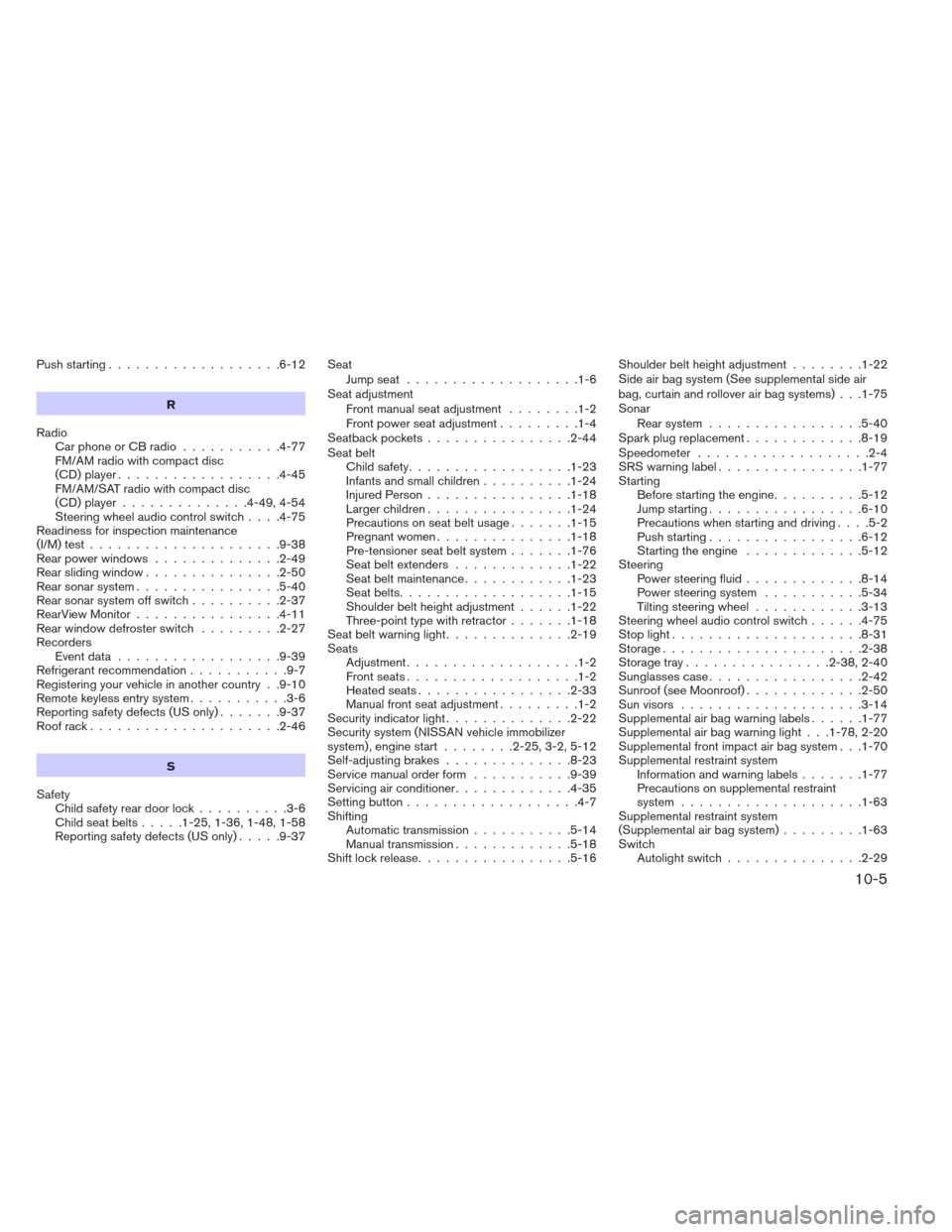
Push starting...................6-12
R
Radio Car phone or CB radio ...........4-77
FM/AM radio with compact disc
(CD) player ..................4-45
FM/AM/SAT radio with compact disc
(CD) player ..............4-49,4-54
Steering wheel audio control switch ....4-75
Readiness for inspection maintenance
(I/M) test .....................9-38
Rear power windows ..............2-49
Rear sliding window ...............2-50
Rear sonar system ................5-40
Rear sonar system off switch ..........2-37
RearViewMonitor................4-11
Rear window defroster switch .........2-27
Recorders Eventdata..................9-39
Refrigerant recommendation ...........9-7
Registering your vehicle in another country . .9-10
Remote keyless entry system ...........3-6
Reporting safety defects (US only) .......9-37
Roof rack .....................2-46
S
Safety Child safety rear door lock ..........3-6
Child seat belts .....1-25,1-36,1-48,1-58
Reporting safety defects (US only) .....9-37Seat
Jumpseat ...................1-6
Seat adjustment Frontmanualseatadjustment ........1-2
Front power seat adjustment .........1-4
Seatback pockets ................2-44
Seat belt Childsafety..................1-23
Infants and small children ..........1-24
Injured Person ................1-18
Largerchildren................1-24
Precautions on seat belt usage .......1-15
Pregnant women ...............1-18
Pre-tensioner seat belt system .......1-76
Seatbeltextenders .............1-22
Seatbeltmaintenance............1-23
Seatbelts...................1-15
Shoulder belt height adjustment ......1-22
Three-point type with retractor .......1-18
Seat belt warning light ..............2-19
Seats Adjustment ...................1-2
Frontseats...................1-2
Heatedseats.................2-33
Manual front seat adjustment .........1-2
Security indicator light ..............2-22
Security system (NISSAN vehicle immobilizer
system) , engine start ........2-25,3-2,5-12
Self-adjusting brakes ..............8-23
Service manual order form ...........9-39
Servicing air conditioner .............4-35
Setting button ...................4-7
Shifting Automatic transmission ...........5-14
Manual transmission .............5-18
Shiftlockrelease.................5-16 Shoulder belt height adjustment
........1-22
Side air bag system (See supplemental side air
bag, curtain and rollover air bag systems) . . .1-75
Sonar Rear system .................5-40
Spark plug replacement .............8-19
Speedometer ...................2-4
SRSwarninglabel................1-77
Starting Before starting the engine ..........5-12
Jump starting .................
6-10
Precautions when starting and driving ....5-2
Push starting .................6-12
Starting the engine .............5-12
Steering Power steering fluid .............8-14
Power steering system ...........5-34
Tilting steering wheel ............3-13
Steering wheel audio control switch ......4-75
Stoplight.....................8-31
Storage......................2-38
Storage tray ................2-38,2-40
Sunglasses case .................2-42
Sunroof (see Moonroof) .............2-50
Sun visors ....................3-14
Supplemental air bag warning labels ......1-77
Supplemental air bag warning light . . .1-78, 2-20
Supplemental front impact air bag system . . .1-70
Supplemental restraint system Information and warning labels .......1-77
Precautions on supplemental restraint
system ....................1-63
Supplemental restraint system
(Supplemental air bag system) .........1-63
Switch Autolight switch ...............2-29
10-5